Generally, there are different types of bikes for different users. So, you ought to identify your cycling need to get a bike that fulfills it.
For example, while mountain bikes are best for off-road cycling, road bikes are ideal for paved roads. And while hybrid bikes are best for commuting, beach cruisers are best for casual riding on flatter terrains.
I’ll discuss all these bikes and many others. I’ll also discuss their subcategories and give relevant recommendations.
My goal is to help you understand the different types of bicycles and their uses. I’ll also offer you a quick buying guide for things to consider besides the bike types.
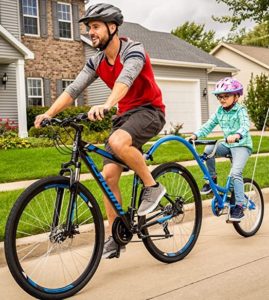
In a hurry? Below is a summary list of different types of bicycles and what they are for.
Different Types Of Bikes (Summary)
- Mountain Bikes – Best for Off-Road Cycling
- Road Bikes – Best for Paved Roads
- Hybrid Bikes – Best for Cruising and Commuting
- Cruiser Bikes – Best for Casual Riding on Flatter Terrains
- Kids Bikes – Best for Children Over 2 Years
- Balance Bikes – Best for Children Below 2 Years
- Folding Bikes – Best for Travelers and Commuters
- Cargo Bikes – Best for Running Errands
- Recumbent Bikes – Best for Seniors
- Tandem Bikes – Best for Two People
- Electric Bikes – Best for Commuting
- BMX Bikes – Best for Stunts and Racing
- Adult Trikes – Best for Older Adults and Commuters
- Fat Bikes – Best for Rougher Off-Road
- Handbikes – Best for People With Leg Disability
- Unicycle – Best for Circus Performance
Different Types Of Bikes Explained! (Types of Bicycles)
1. Mountain Bikes (Best for Off-Road Cycling)
Mountain bikes are your go-for bikes when you want to conquer the hills, cycling trails, rocky grounds, and other unpredictable off-road terrains.
These bikes have flatter handlebars and slightly wider tires with lots of traction to ride off-road comfortably. But still, mountain bikes can take on paved surfaces.
Most of them come with a suspension to cushion your ride.
Different Types Of Mountain Bikes
They include:
a) Rigid Mountain Bike
Some bikes don’t have a built-in suspension, and we call them rigid bikes. Most of these bikes come with fat tires, which absorb bumps to make up for the lack of a suspension.
Those MTBs that don’t have fat tires are usually less comfortable off-road, thus only ideal for less extreme conditions.
The advantage of rigid MTBs is that they are lighter since they lack suspension.
Recommendation – Mongoose Malus Mountain Bike (View on Amazon)
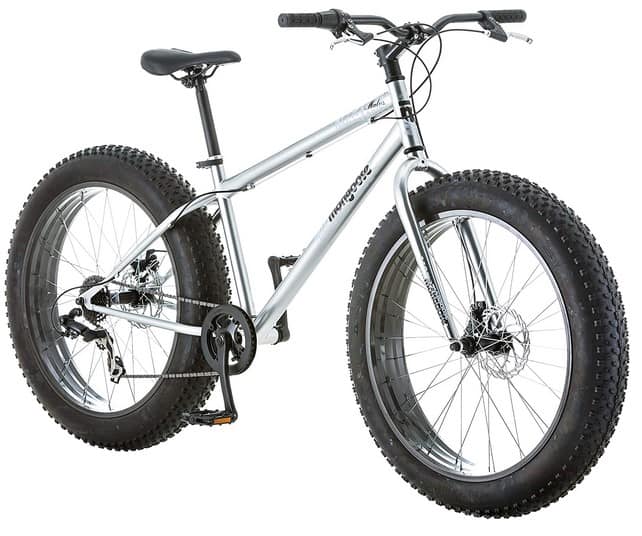
b) Hardtail Mountain Bike
Hardtail mountain bikes are a type of mountain bike with only a front suspension.
While their front suspension can absorb bumps, they are not as strong as full-suspension systems (discussed below), which means they aren’t the best for extreme terrains.
They can, however, take on gravel roads and forest trails. Their advantage is that they are cheaper than full suspension.
c) Full-Suspension (or Dual Suspension) Mountain Bike
Unlike Hardtail MTBs, full-suspension mountain bikes have suspension at the front and rear wheel. As a result, they offer maximum shock absorption and vibration dampening.
These mountain bikes are also known as dual-suspension MTBs for featuring double They are generally heavier than the other two for featuring double suspension.
In general, their dual suspension makes them perfect for harsher terrains. They are, however, costlier than the others.
Recommendation – Schwinn Traxion Mountain Bike (View on Amazon)
More Mountain Bike Subtypes
Also, note that the above mountain bikes could also be further broken down into the following:
Downhill Mountain Bikes
Downhill MTBs are designed to take on rough downhills. So, they come with lots of travel (of up to 200mm).
While they are unmatched downhill, they are not the best uphill, even though you can ride them there. The MTBs enjoy a more relaxed geometry and a slack head tube.
Enduro Mountain Bikes (All-Mountain Bikes)
Enduro mountain bikes are the most rugged mountain bikes suited to the most technical and harshest trails. They are the type that can take on the steepest hills.
They can take on the ascents and descents. Overall, these MTBs come with full suspensions, which enjoy lots of travel.
Trail Mountain Bikes
Trail mountain bikes are usually full-suspension MTBs with better climbing efficiency, off-road balance, and downhill speed to take on just any trail.
These MTBs come with full suspension and enjoy lots of travel (about 130-170mm).
They feature a slacker head tube angle of about 65-68 degrees to offer you more stability.
Cross Country (XC) Mountain Bikes
Cross country MTBs are usually the lighter and often the speedier categories of mountain bikes that are best for moderate trails.
From their names, these MTBs are best for the unpredictable countryside, but they can also take on gravel surfaces.
These bikes allow you to do stunts, and they can come with or with no suspension.
Those with suspensions have enough travel (about 100-120mm).
Also Read: Mountain Bike Brands to Avoid
2. Road Bikes (Best for Paved Roads)
Road bikes are what their names suggest. These bikes are for riding on paved surfaces.
They are lightweight and come with skinner tires to roll smoothly on paved roads.
Most of them come with drop-bar handlebars to allow you to lean forward when riding (an aerodynamic position) to reduce air drag and move faster.
Different Types Of Road Bikes Explained!
They include:
a) Gravel Bikes (or Adventure Bikes)
Gravel bikes come with broader, robust, and knobby tires that enjoy a lot of traction on gravel and other unpaved surfaces.
They, however, go faster off-road, making them the best for Bikepacking and off-road travels.
Recommendation – Diamondback Haanjo 6c Gravel Road Bike (View on Amazon)
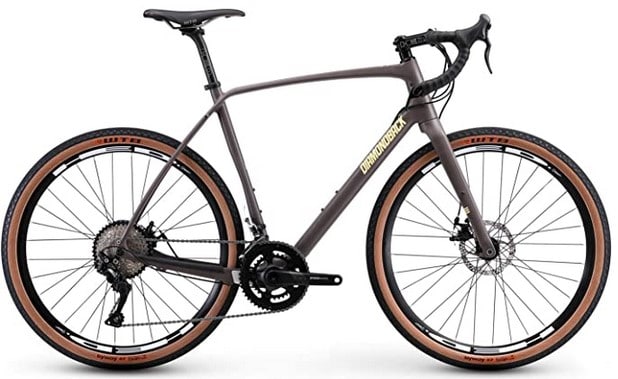
b) Cyclocross Bikes (or Cross Bikes)
Cyclocross bicycles are a type of road bike that you can ride on-road and off-road. Though they look like traditional road bikes, they work more like mountain bikes.
Cyclocross bikes have more powerful disc brakes and more relaxed geometry.
c) Triathlon (or Time-Trial Bikes)
Triathlon or time-trial bikes, as the name suggests, are best for triathlon races and time-trial events. For that reason, these road bikes are more aerodynamic to put you in a more aggressive and wind-resistant position.
So, they sacrifice comfort for an aerodynamic posture to allow you to ride long-distance. Because of their endurance, these bikes are often costlier, some costing over $3,000.
d) Touring Road Bikes
If you are looking for a road bike that you can use to cruise the country, a touring bike is ideal.
The bikes have a much sturdier frame, which is slightly heavier and often makes them slower.
However, the sturdiness of the frame allows you to carry a few heavy supplies on your biking tour.
e) Fixies (Fixed-Gear or Track Bikes)
Fixies have a drivetrain whose cog or sprocket is threaded onto the rear wheel’s hub. As a result, you have to pedal for the cycle to move.
And when the rear wheel takes a turn, the pedals reciprocate.
Different Types Of Fixie Bikes
- Fixed-gear freestyle bikes – These include BMX and other bikes used to perform freestyle tricks. (see example under BMX)
- Track Fixie – These Fixies are optimized for racing on tracks (see the below recommendation)
Recommendation – 6KU Aluminum Fixie Urban Track Bike (View on Amazon)
f) Endurance Road Bikes
Endurance road bikes come with slightly broader tires, unlike traditional road bikes, to offer you more grip and stability.
These bikes enjoy a more relaxed cycling posture to improve your comfort when riding long-distance.
Recommendation – Tommaso Imola Endurance Road Bike (View on Amazon)
g) Racing Road Bikes
These bikes are optimized for the ultimate speed, thus best for on-road racing. They are lighter than most road bikes and easier to maneuver on the streets.
They have a drop-bar handlebar to allow you to lean forward, reduce wind drag, and gain more pedaling leverage.
3. Hybrid Bikes (Best for Cruising and Commuting)
Hybrid bikes have the features of road bikes and mountain bikes. They bring the two worlds together to allow you to ride on-road and off-road seamlessly.
So, their versatility is irrefutable.
Overall, hybrid bikes are best for cruising and commuting across varying terrains. They are more casual, and you’ll get them on a budget.
Different Types Of Hybrid Bikes
a) Comfort Bikes
A comfort bike doesn’t resemble a road bike or MTB, which confuses many as all hybrid bikes are supposed to resemble the two.
Instead of a road bike’s drop-bar or an MTB’s flat bar, these bikes have a high-rise handlebar that is easy to control.
They also have richly cushioned seats, thus the name comfort bikes, and feature wider tires.
These bikes are not best for speed riding or serious off-road cycling. So, they are only best for casual riding on urban roads.
Recommendation – Schwinn GTX Comfort Hybrid Bike (View on Amazon)
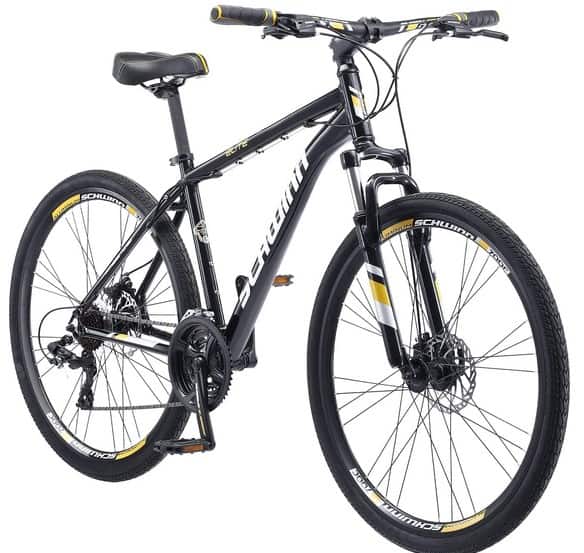
b) City Bikes
City bikes are what they sound like. These bikes come with fast-rolling tires that allow you to cruise the city smoothly.
They are primarily single-speed bikes, which means you have to pedal a lot. The cycles have a vintage look.
c) Commuter Road Bikes
Commuter bikes are hybrid bikes meant for commuting, as the name suggests.
They come equipped with essential add-ons like fenders, racks, lights, bags, and locks to allow you to commute conveniently.
So, if you want to save on daily transportation, consider commuter road bikes.
d) Trekking Bikes
Trekking bikes come with a decent gear range to allow you to cycle uphill comfortably. That makes them best for hilly roads.
Their frames are lightweight, and they come with a front suspension for bump absorption.
They also feature rear racks and sometimes pannier for carrying a few supplies on the go.
e) Sport Hybrid Bikes
Sport hybrid bikes are hybrid bikes that closely resemble mountain bikes in appearance and functionality.
So, they feature a mountain bike’s flat bar, front suspension, and disc brakes. Like mountain bikes, sport hybrid bikes have a wide gear range to take on various trails and paved roads.
So, if you want a bike that you can ride on off-road trails and urban roads, go for a sport hybrid bike.
Recommendation – Schwinn Vantage Sport Hybrid Bike (View on Amazon)
4. Cruiser Bikes (or Beach Cruisers) (Best for Casual Riding on Flatter Terrains)
Cruiser bikes usually have an upright riding geometry that makes them ideal for casual riding on flatter terrains. That includes beaches, urban roads, and parks.
Most of these bikes come with fenders, chainguards, rear racks, and matching grips to promote a retro look. These bikes are more of riding comfort and style than performance.
Most of them cost under $1000, making them budget-friendly. So, if you are looking for a casual bike, you can ride comfortably around town, go for beach cruisers.
Recommendation – Schwinn Mikko & Huron Beach Cruiser (View on Amazon)

5. Kids Bikes (Best for Children Over 2 Years)
Kids also have specific bikes that are tailored for their cycling needs.
These bikes usually come in a wide range of wheel sizes, ranging from 12-inch to 24-inch, and they mostly suit kids who are at least two years.
Kids younger than two years should go for balance bikes.
While most children’s bikes cost under $500, several high-end options cost $1000 or more.
Recommendation – Schwinn Children’s-Road-Bicycles Koen (View on Amazon)
6. Balance Bikes (Best for Children Below 2 Years)
Kids who are younger than two years need to learn to balance before they can learn to pedal. So, they need pedal-less bicycles that we call balance bikes.
The bikes enable the kid to learn to stand on the bike and steer it over a short distance. Once they do, you can then introduce them to regular kids’ bikes with pedals.
Recommendation – Strider -12 Sport Balance Bike (View on Amazon)
Relevant: Are Strider Balance Bikes Worth it?
Specialty Bikes – Different Types of Specialty Bikes
A few other types of bikes don’t fit in any of the categories I’ve shared above. These bikes have some unique specs that make them ideal for specific purposes.
We call them specialty bikes, and they include these different types of bikes and their uses:
7. Folding Bikes (Best for Travelers and Commuters)
Folding bikes are what they sound like. These bikes come with a foldable frame that you can collapse seamlessly to store and carry conveniently.
Most of them can fit in a carry bag, making them more ideal for travelers and commuters who use public transport lines.
The bikes come with smaller wheels than others and an extra lightweight frame.
Recommendation – Schwinn Loop Adult Folding Bike (View on Amazon)
8. Cargo Bikes (Best for Running Errands)
Cargo bikes come in more robust construction and have a wider wheelbase to allow you to haul heavy loads.
They have a sizeable rear rack for loading the cargo and sometimes a front cargo bin for extra storage.
Overall, these bikes are ideal for running errands, especially on flat roads, as they offer you more room for carrying stuff.
9. Electric Bikes (or E-Bikes) (Best for Commuters and Seniors)
Electric bikes are specialty bikes with an integrated motor for pedal assistance and a rechargeable battery to power the motor.
Most e-bikes average a top speed of 20mph, but some, especially high-end options, double the rate or more.
Overall, e-bikes suit commuters more, more so those who are too lazy to pedal or just want to save on energy.
That means they are also best for seniors as they don’t have to pedal a lot.
You can get a decent e-bike for $1500-$4,000 or more, depending on the types of e-bikes.
Recommendation – Swagtron Swagcycle EB-5 E-Bike (View on Amazon)

10. Recumbent Bikes (Best for Seniors and Guys with Back Issues)
While most bicycles allow you to cycle while leaning forward or upright, recumbent bikes let you pedal while leaning backward to reduce pressure on the back.
For that reason, these bikes are best for seniors and people with back issues.
Though they come geared, they aren’t the best choice for mountainous terrains.
11. Tandem Bikes (Best for Two People)
Tandem bikes are specialty bikes that allow two people to cycle at a time. They are primarily for casual riding, especially on smoother roads.
However, a few others come with a wide gear range to allow you to ride uphill and downhill.
Given that both cyclists pedal the bike, it’s much easier and funnier to ride, especially by couples.
Recommendation – Schwinn Twin Classic Tandem Bike (View on Amazon)
12. BMX Bikes (Bicycle Motocross) – Types of BMX Bikes
(Best for Stunts and Racing)
BMX bikes come with smaller wheels, mostly 20-inch, and rugged frames to allow you to race or perform stunts on the streets.
You can use them to perform jumps, spins, and other cycling stunts.
BMX bikes are generally single-speed, and interestingly, some don’t have brakes.
Different Types Of BMX Bikes
They include:
a. Freestyle BMX
Freestyle BMX bikes feature stunt pegs on the wheels that allow you to perform tricks on the streets much more manageable.
They are slightly heavier than race BMX bikes but are much stronger to hold up well when doing serious impact stunts.
Recommendation – Mongoose Legion Freestyle BMX (View on Amazon)
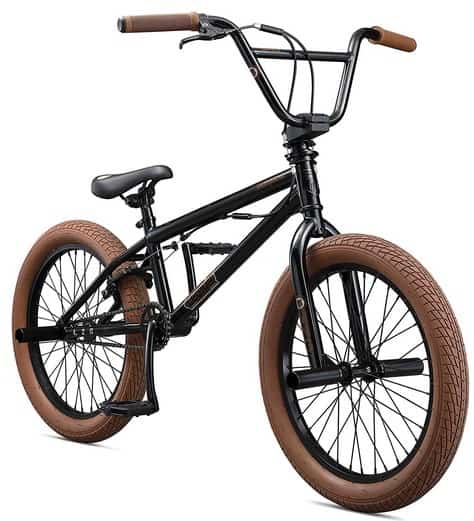
b. Race BMX
Unlike freestyle BMX, race BMX bikes are designed for fast racing on dirt paths and tracks. They are lighter than their siblings to allow you to cycle faster.
Sadly, they are not as more robust as freestyle BMX. So, they are not best for freestyle stunts.
Recommendation – Mongoose Title 24 BMX Race Bike (View on Amazon)
13. Adult Trikes (Best for Older Adults and Commuters)
Adult trikes are three-wheel cycles that are mostly cargo bikes and recumbent.
Given that they have three wheels, they are more stable and have a massive load capacity to allow you to carry a few supplies.
Overall, trikes are best for seniors who are not confident riding a traditional two-wheel bike. But still, they are a good choice for commuters who carry stuff on the go.
Recommendation – Schwinn Meridian Adult Tricycle (View on Amazon)
14. Fat Bikes (Best for Rougher Off-Road)
A fat tire bike conquers terrains that the average mountain bike cannot beat. That includes loose sandy beaches, thick muddy roads, snow surfaces, and dirt trails.
But unlike mountain bikes which can take on both short and long trails, fat bikes are only best for short adventures. That’s because they are heavier and considerably slower if you compare them with regular MTBs.
Recommendation – Mongoose Dolomite Fat Bike (View on Amazon)
15. Handbikes (Best for People With Leg Disability)
Handbikes are not your regular bicycles. They look like recumbent bikes, but unlike recumbent bikes and other bikes, handbikes are pedaled by the arms and not the legs.
So, they are best for people with leg disability who have to commute from one point to another.
16. Unicycle (Best for Circus Performance)
While regular bikes come with two wheels and trikes come with three wheels, unicycles only have one wheel.
They, however, feature a saddle, pedals, and robust frame.
Professional circus artists use unicycles to entertain at events. Remarkably, some young people nowadays use them on trails and to play hockey.
Recommendation – Fun 20 Inch Wheel Unicycle (View on Amazon)
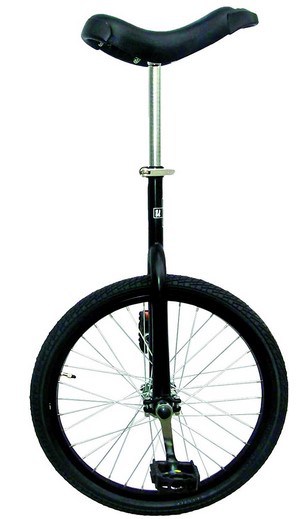
Other Bike Buying Considerations (Other than Types of Bikes)
While you must pick a bike type that suits your cycling needs, there’s more to consider.
They include:
- Frame Quality
Consider a bike frame that fits not only you but also one that’s lightweight, rust-protected, and strong. Most bike frames feature aluminum, which embodies those qualities.
Steel (though heavier) and carbon fiber are decent choices too.
- Correct Wheel Size
Note that smaller wheels are more maneuverable and lighter, but larger wheels offer you more traction and strength, and they roll much faster.
So, it’s a matter of knowing what you want more.
- Good Brakes
Most bikes come with either rim brakes or disc brakes, and you have to choose between them. While rim brakes are cheaper and easier to maintain, they are not as powerful and efficient as disc brakes.
So, got for disc brakes if you want the most responsive and most reliable bike brakes.
- Suspension
If you plan to buy an MTB, then a suspension is a must-consider unless you plan to get a fat tire MTB.
Most hybrid bikes also come with suspension. Overall, the bike’s suspension should be firm and with lots of travel to absorb as much vibration as possible.
Closing Thought on Different Types of Bicycles:
Now you know the different types of bikes and what they are best for. So, you only need to refer to the above guide to know what bike to get for your cycling needs.
Frequently Asked Questions
Can you enumerate the different types of bicycles?
A diverse range of bicycles exists catering to every rider’s specifics. For instance, *hybrid bikes* adeptly borrow attributes from road bikes and mountain bikes to create an optimal blend. They inherit lightweight frames and larger 700C wheels from road bikes, enabling ease of maneuver in urban environments. Mountain bikes confer their flat handlebars and robust brakes, either disc or cantilever, augmenting control and adaptability. The bigger wheels enhance their agility, making them faster around town compared to mountain bikes. Other significant categories include road bikes, mountain bikes, cruiser bikes, and specialized sports bikes each crafted for a unique purpose.
What are bicycles used for?
Bicycles have found an extensive spread of applications, ranging from simple transportation to recreational activities and even sports engagements (commonly known as cycling). In many regions globally, they stand as indispensable tools for locomotion, especially where access to automobiles is limited. Quite often, bicycles serve as primary means for people and goods transportation. Intriguingly, there exist twice as many bicycles worldwide as there are cars. Additionally, bicycles’ historical popularity remains unchallenged with sales outdoing those of automobiles at a ratio of three to one.
Which bicycle is ideal for daily use?
Selecting the perfect bicycle for daily use depends largely on your specific needs and preferences. Considerations include the type of terrain you’ll frequently be cycling on, the distance you intend to cover, and the level of comfort you desire. For city commuting on paved roads, a hybrid or a city bike would be perfect thanks to its comfortable upright position and fast rolling wheels. If you are looking to venture off-road or navigate rugged terrain, then a mountain bike with its sturdy build and suspension would be more suitable. Lastly, if speed is your priority, a road bike with drop handlebars and thin, high-pressure tires would be the best fit. Understanding these various types will help you decide on the most ideal bicycle to suit your daily needs.